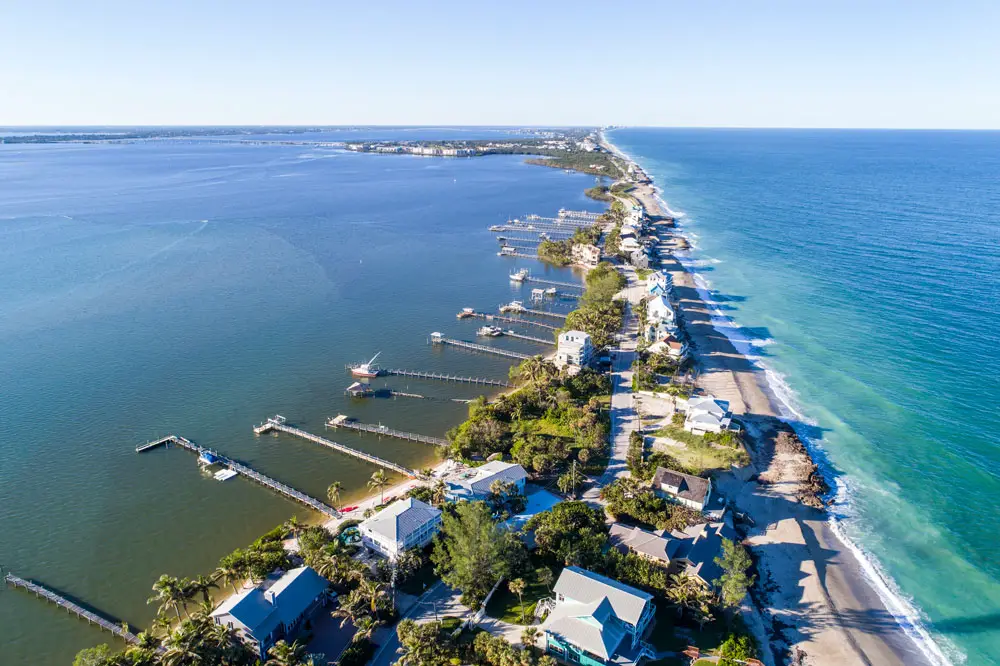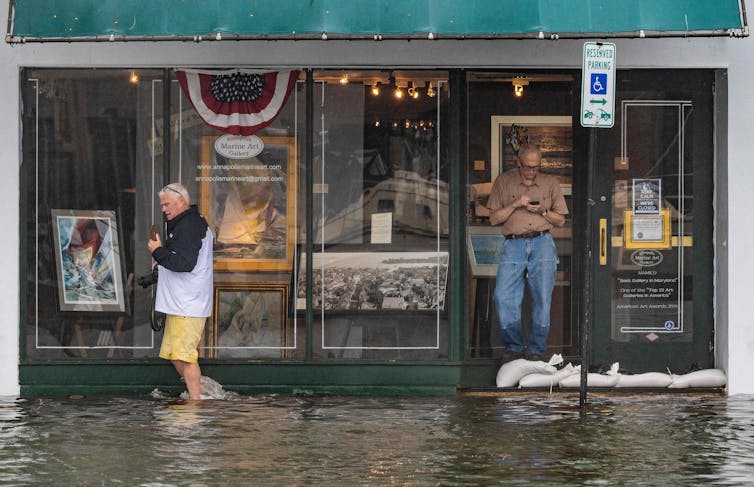
By Risa Palm and Toby W. Bolsen
Apollo Beach, Florida, is a maze of canals lined with hundreds of houses perched right near the water’s edge. The whole community, just south of Tampa, is only about 3 feet above sea level, meaning it’s at risk from storm surge as sea levels rise.
Homebuyers along the U.S. coasts can check each property’s flood risk as easily as they check the size of the bedrooms – most coastal real estate listings now include future flood risk details that take climate change into account. In Apollo Beach, for example, many of the properties are at least 9 out of 10 on the flood risk scale.
That knowledge isn’t stopping homebuyers, though.
Waterfront homes are selling within days of going on the market, and the same story is playing out all along the South Florida coast at a time when scientific reports are warning about the rising risks of coastal flooding as the planet warms.
We are professors of urban geography and American politics who follow the real estate industry. To understand why people are ignoring a risk that could lead to expensive damage and eventually lower their property value, we talked to hundreds of Florida real estate agents about their clients’ motivations and concerns.
Here’s what we learned.
Nothing pushes buyers to consider long-term risk
We surveyed 680 licensed Florida Realtors in late 2020. Their responses suggest that prospective homebuyers, by and large, are not taking elevation or flood vulnerability into account when searching for new homes, and the availability of detailed flood risk maps has had little or no impact on them.
Part of the problem may be that mortgage lenders and appraisers aren’t accounting for properties’ vulnerability to sea level rise, so homebuyers aren’t immediately feeling the risk in their pocketbooks. Wealthier buyers who don’t need a mortgage aren’t required to purchase flood insurance, and Congress has a history of rolling back flood insurance rate increases.
In short, nothing is forcing buyers to consider the long-term risks.
At the same time, studies are clearly showing how risks translate into costs. One recent paper by scientists who create flood risk maps found that Hillsborough County, Florida, home to Apollo Beach and Tampa, is likely to see a 70% increase in annual flood damage by 2050 because of climate change. That’s less than a 30-year mortgage away.
What real estate agents are hearing
We reasoned when we started the survey in 2020 that if some segment of the population was avoiding property at risk of flooding, then demand should decline and prices should fall. Our previous survey in 2018, involving coastal Florida homeowners, had found that Republicans and Democrats alike believed that their future home values would not be affected by rising seas.
To test the theory that the market is largely ignoring flood risk, we asked real estate agents what they saw: To what extent had they observed house prices either falling or not rising as rapidly for properties at risk of flooding? Forty-five percent reported “not at all.” Only 11 of the 680 agents indicated that house prices for properties at risk of flooding were “very frequently” stagnating or falling.
We also asked if they had seen mortgage lenders declining loan applications or increasing charges for loans in flood-prone areas, in the form of points or mortgage insurance, for example. Sixty percent said, “not at all,” and only 7% said “somewhat frequently,” “very frequently” or “all the time.”
The vast majority of agents, almost 70%, said they expect little impact on the property market in the next five to 10 years.
Here’s some of what they said.
“People are and will still buy in the coastal areas of Florida, and if they are buying, there will be no decrease in value. The largest pool of buyers driving market are retired or soon to be retired people and they have the belief that they will be long gone before there is any impact from climate change. They mainly are buying on emotion and not factoring in the long-term cost of ownership. They are also buying with cash and no mortgage.”
Even lenders currently have no real incentives to decline mortgage applications for properties at risk from future sea level rise. Federal agencies that purchase conforming mortgages do not currently require the collection of information about flood risk or likely sea level rise. If these requirements were to change, then flood risk would be translated into lending decision.
“Buyers of coastal properties are financially able to be more risk-oblivious and can afford the higher rate for insurance or be self-insured. Sea-level rise is not currently top-of-mind in our local market.”
Federal flood insurance has been heavily subsidized by U.S. tax dollars for years. In fact, the National Flood Insurance Program owes the U.S. Treasury about $20 billion for expenses exceeding the premiums homeowners pay. As of April 1, 2022, all of its new and renewed flood insurance policies will be subject to a new pricing system termed Risk Rating 2.0 designed to take risk into account.
But the program faces political pressure from members of Congress to ensure rates do not rise too quickly or get too high. Further, buyers who purchase houses for cash, a relatively large part of the market in South Florida, are not subject to flood insurance requirements.
“Wealthy people will still be enamored by the idea of living in front of the sea, but they will probably spend a lot of money making the property more resilient to the effects of sea-level rise. This means that maybe the demand for high end properties will not weaken so much.”
A few agents suggested that wealthy homeowners are taking the risks seriously and plan to invest in structural changes such as elevating homes that could make their properties safer from sea level rise and storm surge.
The market isn’t integrating long-term risks
Because of rising sea levels and storm risks resulting from climate change, we conclude that many of the houses currently being sold in south Florida will not outlast their 30-year mortgages without damage or expensive adaptations, and that the resale of houses vulnerable to sea level rise is very likely to become increasingly difficult.

Jim Watson/AFP via Getty Images
Florida policymakers to date have either ignored the risk or have taken only limited measures to patch weaknesses, sometimes increasing the risks elsewhere. For example, when sea walls are erected, they can change how sand washes in, increasing erosion in neighboring areas.
Many people believe “the market” will take care of this issue: that homebuyers, recognizing the looming risks, will discount prices on vulnerable properties, eventually reducing their attractiveness and value. But what we heard from Florida real estate agents casts doubt on the assumption that the market has yet integrated this risk.
![]()
Risa Palm is Professor of Urban Studies and Public Health at Georgia State University. Toby W. Bolsen is Associate Professor of Political Science at Georgia State University.





























marlee says
There is a development proposal that includes a massive RV park in
Marineland.
There will be a workshop to discuss their Comprehensive Plan changes at the Marineland Coastal Policy Center (9601 N Oceanshore Blvd, Marineland, FL 32137) on Thursday March 31 from 2:00 – 4:30 PM.
Itallbeforeheard says
Bull.
1. I first heard of imminent coastal flooding sixty years ago in grade school. So far A1A is still dry.
2. Most people who can afford coastal property can consider the money spent as disposable income.
3. People have the freedom (for now) to purchase what they can afford and live life with all the risks they want.
Don’t bite your lip and wring your hands over this non-issue while we have an idiot in the Whitehouse.
Brian says
Had an idiot and a traitor in the White House, thank God it is gone. Just wish it would go away now.
Deborah Coffey says
Wait until you see YOUR insurance premiums after the next hurricane hits the oceanfront homes! BTW, A1A has not been dry in lots of places. We on the left prefer facts.
Percy's mother says
Ever been through a REAL hurricane “Itallbeforehand”?
For those who don’t know or understand, the storms we’ve had come through here (three in 2004, 2016 AND 2017) weren’t hurricanes in the real sense . . . they were remnants of hurricanes . . . tropical storms.
Having experienced two direct hits of category 3 hurricanes both times, I can assure you that no one in this area is ready for the effects of a REAL hurricane. Living through a REAL hurricane is enough to give one PTSD. When you emerge into the world in the aftermath, you’ll see massive flooding from rain and storm surge, trees flattened, roofs torn off, etc.
I think “Itallbeforeheard” doesn’t have a clue what he/she is talking about. But then again, this commenter would be the first to apply for government funding if his/her house on a barrier island were to be completely demolished from wind and storm surge during and after a REAL hurricane.
But I get the impression this commenter knows “everything”.
Justsayin says
I sure hope the Obama seen this story. It would very sad to see his multi million dollar home on Martha Vineyards be damaged from raising seas. John Kerry should worry about his home too. #hypocrite!!!!!!
DaleL says
I just checked and the expected sea level rise by 2050 is 10 to 12 inches. There is more uncertainty as to the amount by 2100, but 36 inches is likely. The story highlighted a location in south Florida, Apollo Beach, which has an elevation of just 3 feet above sea level. Obviously, by 2050, if the predictions are correct, those properties will experience significantly more flooding and by 2100 they will be constantly flooded.
However, we live in Flagler County, not Apollo Beach. The best information as to the risk of flooding is to look back to 2016, Hurricane Matthew, and 2017, Hurricane Irma. The storm surge from Matthew flooded many streets in The Hammock. Several homes in my neighborhood were flooded. Homes which were elevated did not flood. The recent housing boom has resulted in a lot of new construction. Despite the experience from less than 6 years ago, some of this new construction is not elevated. At least a couple appear to be no higher than that of homes which were flooded in 2016. This is a huge mistake.
When my wife and I had our house built in 2015, we did a lot of research. As a result we spent about $20,000 extra for fill to elevate our house. By doing so we obtained the lowest possible flood insurance rate. Then just months after we moved in, it paid off handsomely when our street flooded because of Matthew.
State and local governments need to have and enforce appropriate building codes. In flood prone areas this should include minimum elevation standards.
Keep Flagler Beautiful says
I did at least two years’ research before moving here in 2015, and even though there were oceanfront or Intracoastal Waterway houses and neighborhoods I really liked, I paid attention to what a friend with the Army Corps of Engineers told me. He had seen the ACE’s 100-year flood plain map for Florida and strongly advised me to look inland and only buy in an X (no flood) zone. I’m really glad I did. The house I originally wanted was hit by a storm surge when Matthew came through, and the all newly renovated interior was ruined. The owners faced enormous out-of-pocket expense and could not live in the house for many months. During Matthew, the screen blew out of the pool enclosure and two enormous oak trees came down on my property. One of them grazed the front corner of my roof. I was very lucky that’s all I had to pay for (since the insurance deductible was $11,000 due to its having been a “named” storm. But I could deal with that because not a drop of water came into the house. Build high and build inland.